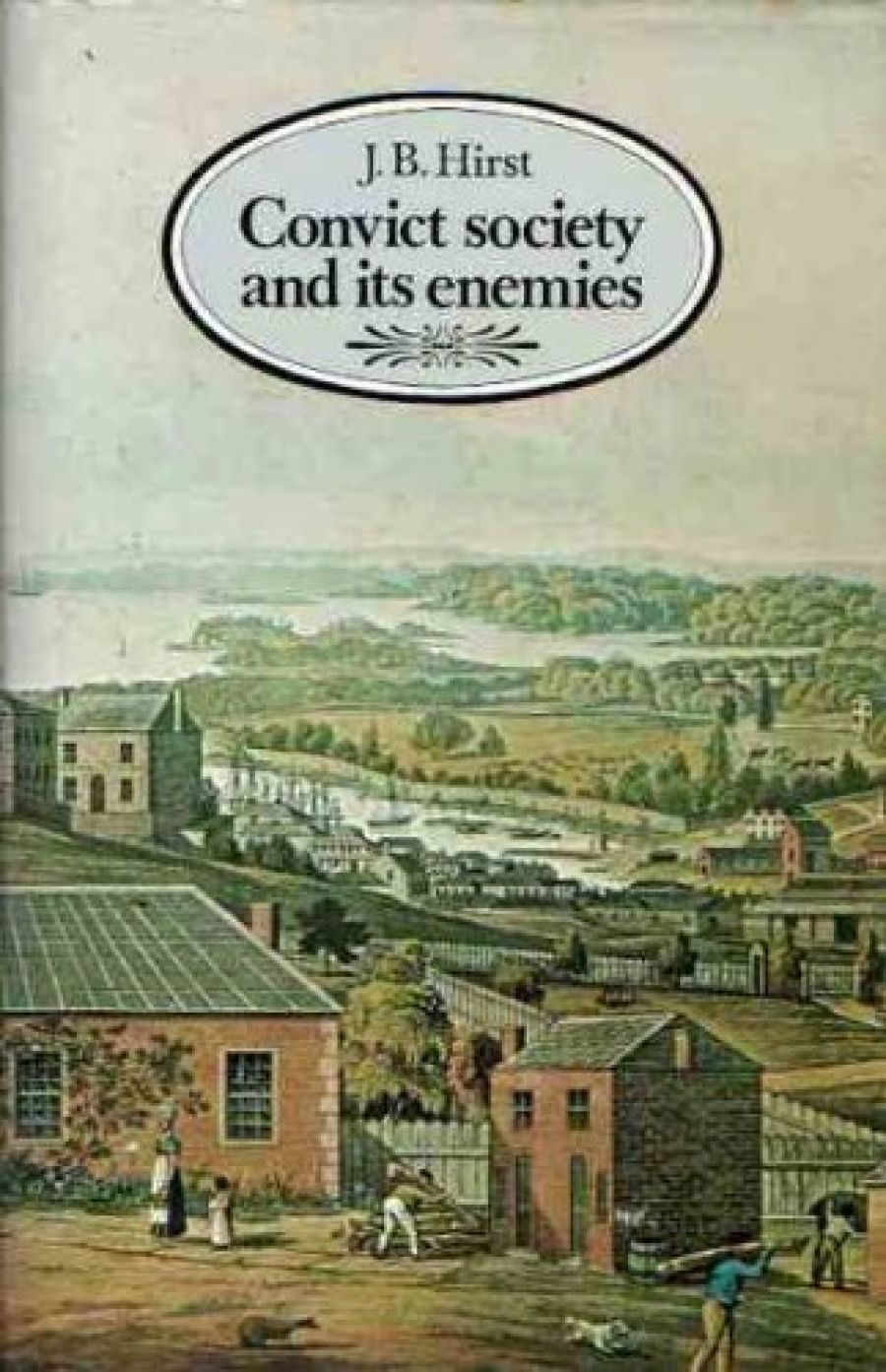
- Free Article: No
- Contents Category: Australian History
- Review Article: Yes
- Article Title: Regeneration at Botany Bay
- Online Only: No
- Custom Highlight Text:
In a major piece of historical revisionism, Dr John Hirst has scrutinised the so-called evils of convict society in New South Wales between 1788 and 1840. Together with a mythology that has stemmed from it. He sees the image of Botany Bay as a place of depravity, where ‘vice is virtue, virtue vice’, as having been created by the opponents of transportation, the late eighteenth-century prison reformers such as John Howard and Jeremy Bentham; he traces their influence through Evangelicals, like Wilberforce, to the liberal Russell and the radical Molesworth who, in the 1830s, saw Australian settlers wallowing with their assignees in a sensual sty. Since the penal colonies would never cleanse themselves, it behoved indignant parliamentarians at Westminster so to do.
- Book 1 Title: Convict Society and its enemies
- Book 1 Biblio: Allen & Unwin $19.95, $9.95 pb, 244 pp
Hirst then challenges those critics of the system who equated a convict with a slave and who believed that the exercise of absolute power corrupted his master. He points to a number of factors that enhanced the degree of freedom enjoyed by assignees: emollient discipline and relaxed supervision, the anodynes of wages and leisure, the granting of indulgences and tickets of leave as incentives to good behaviour, above all, the reluctance of employers to bring charges against their convicts because of chronic labour shortages. Given the background of most felons, their masters had to struggle to get them to work at all and, perforce, settled for labour that was less than satisfactory. The behaviour of employers varied: some were kind and forbearing, considerate, and just; others were firm and severe; most took a middle course. Rather than being at the mercy of their masters’ whims, convicts could only be flogged by order of a court; while many suffered the lash for drunkenness or absenteeism, they had committed offences in which prisoners under more rigid discipline than obtained in New South Wales had no opportunity to indulge.
Hirst draws attention to the relative absence of restraint in penal New South Wales. There were no bars on convicts’ sexual relations, or on their economic activity: some became shopkeepers and traders, clerks, and schoolteachers, while still technically bonded: seventy-five per cent of the transportees had been sentenced to limited terms and, on their release, might receive land, stock, grain, and assigned servants of their own. The attempt by local administrators to reduce costs meant that the colony’s development cut across penal discipline, placing premium upon a convict’s skill rather than his offence. The comparison with slaves seems dubious for, by law, felons retained rights as subjects of the Crown: they could own property, sue in the civil courts, appear as witnesses, give evidence against their masters, and petition for the redress of grievances. En masse they rebelled only twice, at Castle Hill in 1804 and at Bathurst in 1830; for the most part the colonists held no widespread or prolonged fear of convict uprising. Beneath the highest ranks of the exclusives, expirees frequently intermingled and intermarried with free inhabitants; some rose to high office: the radical press acted as their watchdog, defending convicts’ rights and emancipists’ privileges. Hirst suggests that New South Wales had regenerative powers: the majority of prisoners, if not contented with their lot, at least accepted the legitimacy of their conviction and were disposed to endure their sentences peaceably in the expectation of an eventual and replete freedom. The legend of the convict taint has lasted until comparatively recent times. If people now speak levelly and without shame about our convict forbears, Hirst’s seminal book will help them with its sense and independence.
John Hirst has relied far more on published sources than on manuscripts; he refers but fleetingly to what the convicts themselves thought and felt; in demolishing the horrific view of convict society, he may have overcompensated and been led to exaggerate his case; with hindsight, historians may wish to push his pendulum back a little. It is puzzling to find no citation of Molony’s Plunkett or McLachlan’s Eagar among the sources, as each would have reinforced his points on pages 200 and 159–161 respectively; the absence of any reference to Clark’s three volumes or to Ellis’s biographies seems churlish. Hirst writes pleasantly, without cliché or unction, but a couple of rhetorical exclamations and one piece of unconscionable intrusiveness (page 172) jar his prose, as does his having people ‘hung’ on page 134. His opening words to Chapter Three, ‘Australia began its life as a jail’, will ruffle prehistorians and Aboriginals, while his remark that the reasons for Macquarie’s emancipist policy ‘will always remain something of a mystery’ uses one word that historians employ at their peril.


Comments powered by CComment